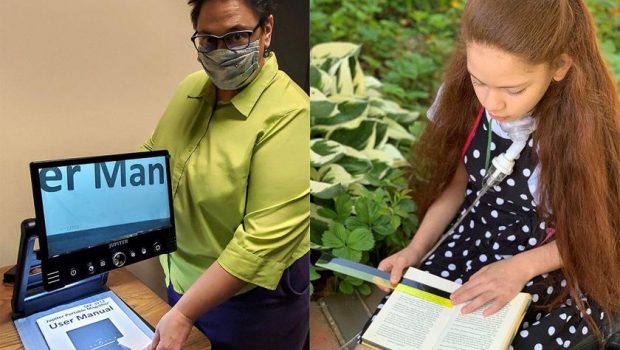OKLAHOMA CITY – Living with COVID-19 has been a challenge in all walks of life, but especially for students, parents and educators across Oklahoma.
Imagine the added hardship if you are a student who is blind or visually impaired – or a parent or Teacher of the Visually Impaired (TVI) trying to make educational materials accessible in virtual classrooms. Many already depend on the Accessible Instructional Materials Center, known as AIM, at Oklahoma Library for the Blind and Physically Handicapped in Oklahoma City.
The library and AIM are reaching out to inform others about this statewide program in Services for the Blind and Visually Impaired, a division of Oklahoma Rehabilitation Services.
“The AIM Center loans braille and large print textbooks and other instructional materials to 875 Oklahoma students who are legally blind and 511 students with visual impairments on Individualized Education Programs in their school districts,” AIM Center Director Pepper Watson explained.
Watson, who has a brother Stephen with low vision, has worked for AIM for 20 years. She handles all requests with the help of three staff: Sheldon Moglia, Cynthia Stokes, Kay Johnson.
The AIM Center receives $417.75 per student in federal funds distributed by American Printing House for the Blind through the Federal Quota program each year. AIM maintains the Federal Quota Registry of children who are blind and visually impaired in Oklahoma. In addition, the Oklahoma State Department of Education annually provides $50,000 designated for technology, which help students participate fully in classrooms.
AIM’s central collection includes an estimated 776 different items, including Chromebooks with larger than standard screens, high tech magnifiers, braille note-takers and large print tools such rulers, keyboard stickers, large print calculators and multiplication and division cards. For example, AIM provides 14 types of refresher braille equipment, which are electro-mechanical devices for displaying characters with round-tipped pins raised through holes in flat surfaces such as keyboards.
“We have different devices for students with different levels of braille proficiency,” Watson said. “You start them out on a Braille Buzz for two to five year-olds, which looks like a fun game with braille keys. Then we have the Braille Trail and next we go to the Chameleon 20, which is a little bit bigger, and then a Mantis, which is bigger than that. Finally, the Focus Forty is for efficient braille readers.”
Items are loaned and reclaimed by the AIM Center when students graduate from high school or the items are no longer needed. Then items are repaired if needed and recirculated to help other students. Devices are usually mailed, but may be personally delivered and set up by AIM or Library staff.
“The Jupiter Portable Magnifier has a camera that points down to magnify reading materials and swings up to enlarge text on classroom board,” Watson said as she demonstrated how text appears on a large monitor. “It’s made for kids who normally have to sit on the front row or get up and go up to the board to copy notes. We set up a Jupiter for a student in Purcell, every kid and the teachers were looking at the detail in a piece of honeycomb magnified on the screen."
Each Jupiter costs about $3,000, which is not affordable for many school districts or families. Approximately 200 special education directors and teachers, including 50 Teachers of the Visually Impaired, and some parents order equipment and educational materials by early spring specifically for each student’s use when school begins next fall.
“During the pandemic, the AIM Center sent braillewriters and other equipment to the kids’ houses so TVIs (teachers of the visually impaired) could Zoom with them to practice braille,” said TVI Cynthia Lumpkin from Fort Gibson, who works with students in several school districts. I could not do what I do without AIM Center and Library for the Blind. They let us order everything to help students in the classroom, and they are so efficient,” Lumpkin added. “Sometimes they get it (mailed) out the same day we ask for it.”
For more information about the AIM Center and Oklahoma Library for the Blind and Physically Handicapped visithttp://www.olbph.org/, phone (405) 521-3514 or (800) 523-0288, or email olbph@okdrs.gov.








Gloss